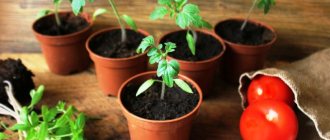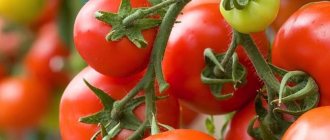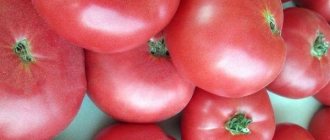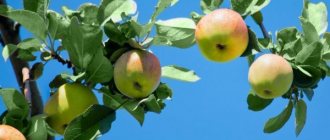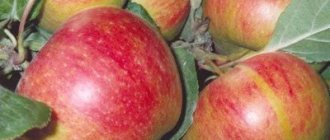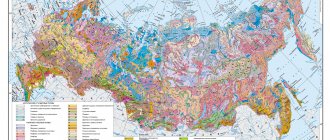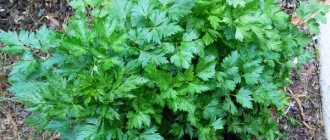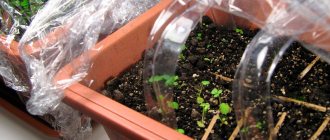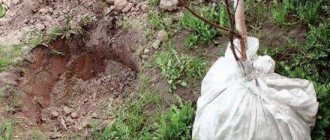Features of planting apple trees in the Moscow region
In the Moscow region, apple trees should be planted in spring or autumn. The best option is to plant a tree in the autumn - from the last days of September to mid-November.
You should also pay attention to the quality of the soil for planting. The fact is that the apple tree does not take root well in swampy areas, in places where groundwater is shallow.
If it is not possible to plant the plant in another place, before planting in such soil, it should be drained using sand or gravel.
Planting in spring can be done from the last days of April to mid-May. Before planting, you must make sure that the ground has warmed up. This can be done with a shovel. You can find out that the soil has warmed up to the optimal temperature if the shovel enters the soil at the level of the bayonet.
How to choose seedlings
When choosing a seedling, you should first of all pay attention to its health. Purchasing planting material from an unknown person is always accompanied by significant risk. In order not to be deceived, the purchase must be made in fruit nurseries.
Gardeners without experience often ask which varieties should be preferred when choosing seedlings. You should buy only those early, middle or late varieties of apple trees that are zoned in your region. If you plant a variety in the Urals zoned in the Kuban, then it is not a fact that this apple tree will withstand a frosty winter.
Particular attention should be paid to the type of rootstock of seedlings. Preference can be given to ordinary apple trees on vigorous rootstocks, but then one must keep in mind that they are quite tall and will require a larger feeding area.
Columnar apple trees, which appeared on the market relatively recently, have gained very high popularity. Like any type of fruit tree, it is recommended to plant such seedlings in the spring or early autumn. If it’s in the fall, then we need to get this work done before September ends.
Which variety should I choose?
The choice of variety depends on when the summer resident plans to harvest. Summer varieties bear fruit from late July-August. Such apples are distinguished by the fact that their shelf life reaches 14 days. Autumn varieties ripen in September and retain their freshness for 1-2 months. Winter varieties delight with their harvest in October. At the same time, such apples are stored for 3-6 months.
Many summer residents plant different varieties of trees on their plots. The best option is to plant 1 summer plant, 1-2 autumn plants, 2-3 winter plants. If you want to grow only one variety in the Moscow region, you should give preference to winter-hardy varieties, since they are resistant to the climatic conditions characteristic of the region.
Summer varieties of apple trees
If a summer resident plans to harvest in the summer, it is better for him to focus on the varieties listed below:
- Melba;
- Moscow pear;
- Candy;
- Padding;
- Lungwort;
- Mantent;
- Pink is excellent.
Autumn varieties
The best autumn varieties are:
- Zhigulevskoe;
- Rossoshansky striped;
- Brown striped;
- Antonovka;
- Spartacus;
- Anise;
- Glory to the winners.
Winter varieties
If it is necessary to harvest in late autumn, preference should be given to growing winter varieties such as:
- Moscow winter;
- Kutuzovets;
- Star;
- Golden;
- Kuibyshevskoe;
- Saffron;
- Northern synapse;
- Richard.
See also
Characteristics and description of the Jung apple tree variety (Snow White), reviews from gardenersRead
Timing of work
There are two main planting periods - spring and autumn. The plant adapts normally to a new place only when it is at rest. Each option has its pros and cons, which are worth studying before deciding what time to carry out the work.
Spring
After winter, all processes in apple trees practically stop, so they tolerate replanting well and quickly adapt to a new place. But there is a possibility of return frosts, which poses a danger. The advantages of planting during this period are:
- The tree has a whole season to take root well. Therefore, the spring option is recommended when using young seedlings (1-2 years old), as well as damaged and weakened plants that cannot quickly take root; there is a high risk of their death in the autumn.
- The soil has a lot of moisture and nutrients. Usually the soil is saturated with water, which improves rooting and ensures rapid development. You can prepare the hole in the fall, then over the winter the nutrients will saturate the soil and the surface will shrink, so the seedling will not sink after planting.
- There are no plants yet. The site is free, it is convenient to accurately plan the location, it is convenient to dig holes, and arrange the territory.
- The young tree develops faster and begins to bear fruit a year earlier.
- It is easy to monitor the condition of the trunk and branches, feed them or treat them for diseases. When carrying out work before winter, it is impossible to understand until spring whether the apple tree has taken root or not.
The optimal period for this type of work is approximately from mid-April to the first ten days of May. It is necessary to determine more precisely by the condition of the soil - it should warm up to the depth of the spade bayonet. Another condition is that the buds on the branches should not open; if this happens, the tree will also take root, but will spend a lot of resources on it. Spring planting also has its disadvantages:
- A large amount of work in the garden and vegetable garden. Because of this, it is difficult to allocate enough time for normal preparation of the site. It is advisable to prepare the pit at least a month in advance, but this is impossible to do in the spring, most often the soil is still frozen.
- There are difficulties with choosing quality seedlings. Nurseries and specialty stores sell the bulk of plants in the fall, and display the remainder for spring. The quality is usually much worse, as is the range.
- An entire season is lost when planting a 3-4 year old tree. It takes time to adapt, so fruiting will begin a year later than it could have been.
- When temperatures rise, seedlings often suffer, and the bright spring sun burns both the leaves and the bark on the trunk. Another disadvantage is the large evaporation of moisture from the soil.
Advice!
To ensure good rooting of the apple tree during spring planting, you need to water it weekly and mulch the tree trunk.
It is worth choosing this time if the trees are small or the appropriate time at the end of the season was missed and frosts occurred. In this case, bury the planting material sideways and cover it for the winter, or place it in a pot with soil and place it in a cool, dark room.
Autumn
Planting an apple tree in the Moscow region in the fall is more preferable, since the work period is long and you can choose the right time without fear of being late. Trees take root well without much hassle if the work is done correctly and the plants are not damaged. The main advantages of this option are:
- Seedlings do not require special care after planting. The maximum that you have to do is water 1-2 times if the autumn is dry and there is no rain for a very long time.
- There is a large selection of planting material in nurseries and stores. You can choose any variety and find a healthy tree with a developed root system. Plus, the cost of apple trees is much lower this season.
- There is free time, since most of the work in the garden has already been completed. You can plant slowly, do the work efficiently and strictly according to technology.
- Convenient to prepare a pit. It is advisable to do this at least a month in advance, which will not be a problem when planting apple trees in the autumn in the Moscow region.
- In spring, the apple tree wakes up immediately after the onset of heat. All processes begin naturally, so there will be no delay in the opening of leaves, as often happens in spring.
In autumn, the timing of planting apple trees is selected based on the prevailing weather. You can start immediately after the leaves fall - this is a signal that the tree has fallen asleep, and finish no later than 3 weeks before the onset of frost. This is exactly how much a seedling needs to take root in a new place. It’s better to have a month or a little more left before the cold weather.
You might be interested in “Lungwort” - an apple tree that is sweet without honey. Is it possible to graft an apple tree onto a wild one and how to do it correctly? Apple tree “Spartan”: characteristics and description of the variety
Planting apple tree seedlings in the fall has its drawbacks, which also need to be taken into account:
- If frost occurs earlier than predicted, the tree may be severely damaged. Without adaptation, apple trees do not survive the winter well and are often damaged.
- Rodents damage young plants much more than older ones. To eliminate this problem, the easiest way is to use coniferous paws that are tied around the trunk.
In the fall, it is much easier to properly plant an apple tree in the Moscow region, since there is little work on the site; you can prepare the hole in advance by adding organic matter and nutritious soil. The main thing is to choose the right moment so that there is time to adapt; it is better to cope a little earlier than to delay and plant before frost.
When can I plant?
If a summer resident plans to plant young seedlings 1 year old, it is better to do this in the spring. This approach to cultivation will allow the root system to adapt to climatic conditions before the onset of winter cold. Such plants need to be planted in late March - early April.
If the seedling is 2-3 years old, it is better to plant it in the autumn. The choice of this season is not accidental; it allows you to save a year until the first harvest. In this case, in order for the tree to survive the winter well, it must be securely covered and all planting nuances must be carefully observed. In autumn, it is better to plant seedlings from the end of September to the last days of October.
At what distance to plant apple trees?
In order for fruit trees to grow and bear fruit normally, it is necessary to maintain a gap between them. At what distance should apple trees (and other trees) be planted from each other? It is recommended to adhere to the following scheme:
- The gap between low-growing and semi-dwarf varieties is 2-3 meters;
- Between medium-sized ones - 3-4 meters;
- The distance between vigorous plants is 5-7 meters;
- But between columnar apple trees a gap of 0.5-1 meter is often left.
Why is it important to plant apple trees at the optimal distance? There are a number of reasons for this, because with excessive intimacy:
- when the crown grows, shading is inevitable;
- there will be competition for food;
- There will be minor difficulties during harvesting and care.
Choosing a landing site
In order to get a healthy plant and a good harvest, before planting you need to choose the right place where the apple tree will be planted. It is best if it has the following features:
- the site is located on a small hill, while it is open and sunny;
- there should be no swampy soil, drafts, shadows from buildings or other plants at the landing site;
- groundwater must be more than 2 meters deep;
- the soil acid-base balance should be neutral.
After the optimal location has been found, it is necessary to bring the soil to its optimal condition, preparing it for planting.
Selection and preparation of seedlings
Before planting a plant, it must be carefully inspected. Seedlings must have a healthy root system, a smooth trunk that is free of damage. The plant must have live buds. Before planting, you cannot cut off small roots, as thanks to them the plant can provide itself with nutrients and water.
A day before transplanting, the seedlings are soaked in a bucket of water. In this case, any stimulator of the root formation process should be added to the liquid. As such additives you can use “Kornevin”, “Heteroauxin”, “Epin”. It is also allowed to use a yeast solution made from 10 liters of water and 100 grams of yeast.
Fertilizers for spring and autumn planting
When planting in autumn, potassium-phosphorus fertilizer is applied.
Autumn fertilizer.
This can be potassium humate, potassium chloride, superphosphate, or a ready-made “autumn” fertilizer mixture.
The main rule is not to introduce nitrogen-containing mixtures (urea, azofoska, bird droppings, fresh manure) in the fall! This fertilizer causes rapid growth of shoots, which will not have time to ripen before winter and will only draw nutrients from the root!
When planting in spring, on the contrary , nitrogen fertilizer will help the tree quickly grow both roots and branches. It is applied when loosening the tree trunk or by dissolving it in water.
The following drugs are suitable:
- Urea. 15-20 grams per seedling;
- Rotted manure, 1 bucket per seedling. They mulch the top layer of soil at a distance of 10 cm from the plant trunk.
- Infusion of bird droppings in the amount of half a bucket. They need to water the apple tree immediately after planting.
Preparing fertilizer for feeding apple trees
Planting scheme
In order for the plant to grow well and bear fruit, it must be planted correctly. To do this, you need to take into account several nuances:
- The hole should be made in height no more than the size of the pot, so as not to deepen the neck during planting.
- Since the soil will settle slightly after planting, it is necessary to make a reserve in height.
- The seedling should be placed in the hole. In cases where the apple tree has an open root system, the shoots must be carefully straightened.
- It is necessary to sprinkle the soil gradually in several layers. In this case, each layer needs to be watered. This approach will allow you to compact the soil tightly and eliminate all air voids from it.
- A peg is driven in next to the plant. It is necessary for support and to prevent the trunk from bending.
See also
Description of the Banana apple tree variety: ripening and fruiting, in which regions it growsRead
After transplantation, the root zone is watered. Then it needs to be mulched. Mulch is required to retain moisture in the root system and protect the planting from weeds. Also, such covering material provides the necessary fertilizing for the apple tree.
How to care for an apple tree seedling
After planting the seedling, use a nylon cord to tie the trunk to a peg, securing it with a free “figure eight” at two points. In order for the crown to form correctly, the crown of a one-year-old seedling is cut off at a height of 70 cm, and the side branches of two-year-old seedlings are cut in the same way.
Water the planted apple tree with two or three buckets of warm water. It is necessary to water in small portions, waiting until the moisture is absorbed. Then the soil in the tree trunk circle is mulched with the remaining soil, pine needles or sawdust. When planting in spring, the layer is made thicker to protect the soil from drying out.
Trees planted in spring are watered once a week, more often in dry weather. The first 2 - 3 times use warm water, then switch to regular water. In mid-August, watering is stopped. In the first year, you don’t need to fertilize – the substances added to the soil when preparing the hole are enough.
Video on the topic “how to plant an apple tree”:
Further tree care
After planting an apple tree, it needs to be properly cared for. To do this, you need to keep the soil clean, regularly carry out sanitary and formative pruning, water, and protect from pests, diseases, and cold weather.
Watering seedlings
In the first month, the plant is watered every week, and 2 buckets of water should be gradually poured under the tree. In dry autumn, additional watering is organized: 2-3 buckets of water are poured under the plant every day. There is no need to fertilize the tree for 2-3 years, provided that the hole for planting is prepared in advance.
Gradually watering is done more abundantly, but less frequently. 4-5 buckets of water are poured under each tree once every 3 weeks. An adult tree needs only 4 waterings during 1 season. They are organized during the period of flowering and fruit set. The rest of the watering is done at the time of pouring the apples, before winter.
Shelter for the winter
If the plant was planted in the fall, the seedlings need to be covered for the winter. This procedure must be carried out for 2-3 years until the plant is fully strengthened. To prepare apple trees for winter, they need to be watered abundantly before the onset of cold weather. After this, the root area is thoroughly mulched. The mulch layer should be at least 7 centimeters. The tree trunk also needs to be protected from the cold. To do this, it should be wrapped with a transparent covering material.
Treatment against diseases and pests
After planting an apple tree, it is necessary to regularly inspect its branches and leaves for the presence of diseases and pests. At this stage, such an inspection is quite easy, since the tree is not covered with many leaves. If signs of disease are detected, it is better to treat the young tree with folk remedies.
If even after treatment the disease does not recede, it can be overcome with the help of safe biological agents, the positive effect of which is based on the vital activity of fungi and microorganisms. Such drugs include “Fitoverm”, “Bitoxibacillin”.
To maintain the health of the plant, it is necessary to pay attention to ensuring that the support peg does not injure the trunk. This is due to the fact that a damaged tree is prone to pests and diseases.
Care at first
To grow a healthy apple tree, you need to create optimal conditions for its development at first, until the tree has become stronger and is growing intensively. Planting and care in the Moscow region have no special features; everything is carried out the same as in other regions. The workflow consists of several stages:
- Water only if there has been no rain for more than 2 weeks. Use warm, settled water; from 20 to 40 liters per plant, depending on the size and degree of dryness of the soil. Stop watering at least 3 weeks before the onset of frost.
- Mulch the tree trunk circle. This will protect the surface from weed growth and retain moisture. Use any available materials: peat, straw or hay, mown grass, weeded and dried weeds, spruce paws. If there is no mulch, loosen the surface after each watering.
- Feed no earlier than 2 years after planting. There are enough nutrients in the pit for the first time; their excess is just as undesirable as their deficiency. From the third year, apply fertilizers in spring and autumn; it is easiest to use ready-made mineral complexes, but you can feed them with organic matter.
- In autumn and spring, carry out preventive treatment against pests and fungal diseases. To do this, use a solution of copper sulfate or Bordeaux mixture. Apply not only to the branches and trunk, but also to the ground under the crown, since fungal spores and insect larvae often overwinter in the soil.
- Whiten the trunk and lower skeletal branches in autumn and spring. This will protect the surface from sunburn in spring and frost damage in winter, and will destroy larvae overwintering in the folds of the bark.
- Trim the crown. Every spring, inspect and remove all damaged and frostbitten shoots. Shape the tree according to the pattern, shorten the top, as well as the ends of the branches, to stimulate the growth of lateral shoots. Treat all saw cuts with garden pitch, oil paint or copper sulfate solution.
- Inspect branches and leaves throughout the season. If foci of disease or pests appear, treat immediately. Until the apple tree begins to bear fruit, you can use any composition.
Advice!
To make whitewash better destroy fungi and insects, add a little copper sulfate solution to it.
Next, provide approximately the same care: monitor the condition of the crown, cut out damaged branches, water during dry periods, whiten the trunk twice a year. In the first seasons, as a safety net, you can wrap the trunk with agro-canvas, and cover the root part with a layer of pine paws or straw for additional protection from freezing.
Planting an apple tree in the Moscow region is not difficult if you follow simple recommendations and choose the right time to carry out the work. It is important to find a good place, prepare a hole, and buy a healthy seedling that will quickly begin to grow. Grow with care tips in mind to protect the tree from diseases and provide everything it needs.
